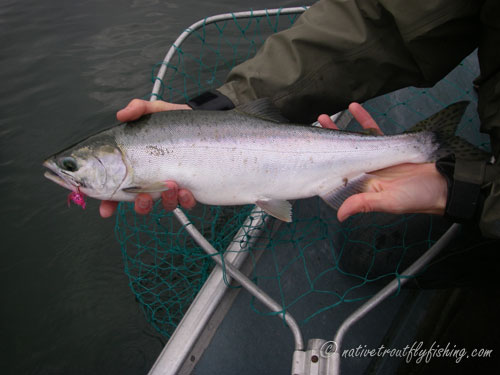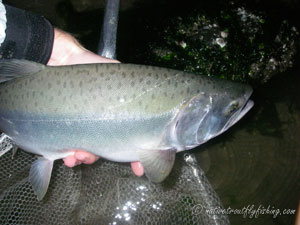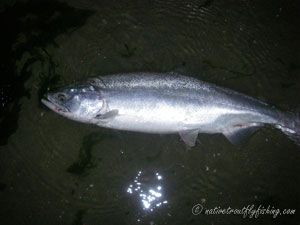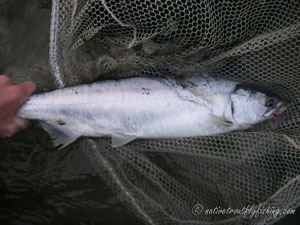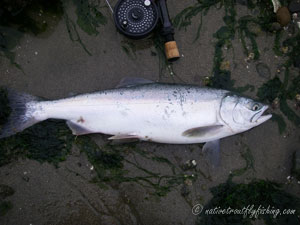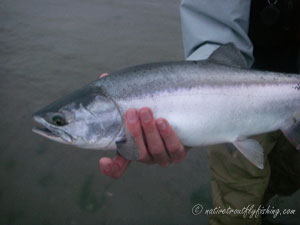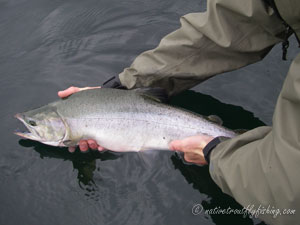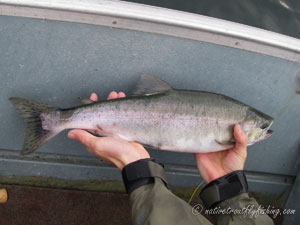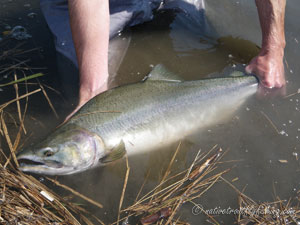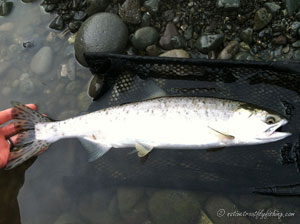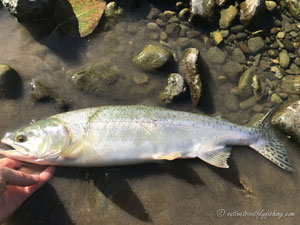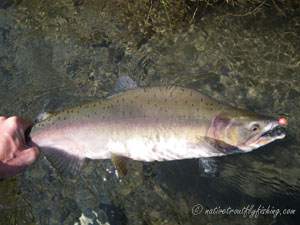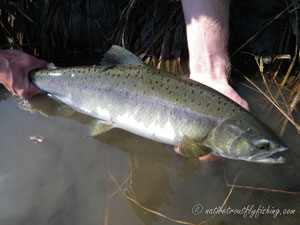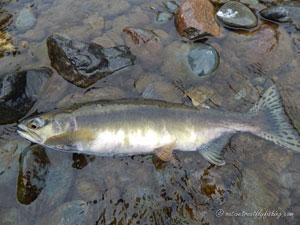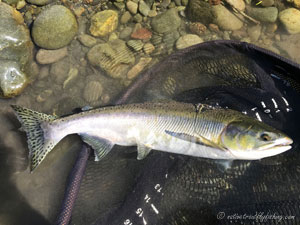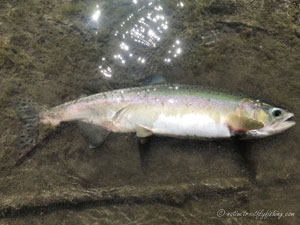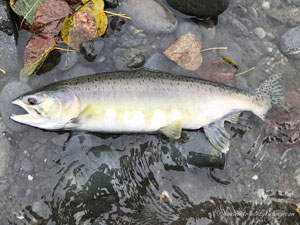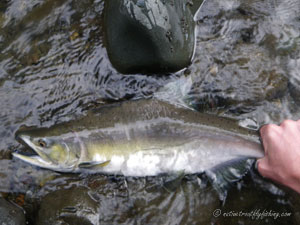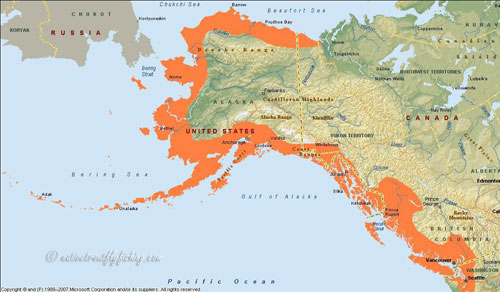Pink Salmon
Oncorhynchus gorbuscha
A Puget Sound pink salmon caught on a baitfish pattern
Introduction
Pink or humpback salmon are the smallest yet most numerous of the North American Pacific salmon. They have acquired the nickname of humpback or humpy salmon due a large dorsal hump that males develop as they near spawning. The world record pink salmon was caught in Washington State's Skagit River in 2001 weighed 14.49lb., but the average size of these fish is much smaller and falls between 3 and 5.5lbs. Like chum salmon due to their numbers and the poorer food quality of their meat, pinks are not held in very high esteem by most anglers.
Life History Information
Pink salmon exhibit a very similar life history to chum during the early stages of their life. Pinks usually spawn between July and October, with spawning occurring earlier in the northern part of their range than in the southern part. In the Puget Sound, Washington pink salmon generally begin arriving in estuarine waters in August and spawning occurs in September and October. As with chum salmon, pinks often begin to exhibit their spawning traits once they reach estuarine waters and degrade relatively rapidly once they enter fresh water. Also like chum salmon pinks are also are known to spawn in the intertidal reaches of streams indicating that their eggs have developed at least some level of tolerance for salinity. However even with this ability to spawn in the lowest reaches of a river system, some populations are known to migrate great distances to reach their spawning grounds. In North America the longest travelled population of pink salmon occurs in Babine River, and these fish migrate 300 miles upstream to spawn (Behnke 2002).
The eggs of pink salmon are small, and generally hatch in 70 to 40 days, but like with all salmonids the incubation period is largely controlled by temperature. Beacham and Murray (1990) showed that pink salmon eggs have the lowest survival rate of any Pacific salmon eggs if the temperature drops below 4°C (39°F). Once they hatch, pink salmon basically make no use of freshwater for rearing allowing them to spawn at very high densities since space and not food is the limiting agent (Quinn 2005). While pink salmon are smaller than chum and chinook when they enter estuarine waters, they have a much shorter period of residence (Quinn 2005). Even though pink salmon spend the least amount of time in estuaries at anywhere between a couple weeks to a few months, these waters remain important and pinks grow at a rate of 5-6% of their body weight per day (WDFW 1993). After leaving their natal stream and the accompanying estuarine waters, pink salmon spend 14 to 18 months in the North Pacific in search of food. This leaves pink salmon concentrated in the northern Gulf of Alaska by their first fall after departing their natal stream. Pinks than move offshore during the winter months and begin their homeward migration during the summer. During this period they opportunistically feed on a diet of invertebrates and fish with majority of their diet being comprised of amphipods (Manzer 1968).
These fish live out a two year life cycle in their native range, which has led to the development of genetically distinct even and odd year populations. In the southern part of their range the odd year life cycle is dominant and appears to be more tolerant of warmer water, while the even year life cycle is dominant in the northern part of their range. It is believed that these two populations may be the results of re-colonization from northern and southern glacial refuges (Quinn 2005). While natural hybrids have been known occur between pink and chum in the wild, the two species have maintained their genetic integrity (Behnke 2002). However with the introduction of pink salmon to the Great Lakes, the different environment led hybridization between pink and chinook and the two species produce viable offspring that are commonly called pinook salmon.
Status
The Pink salmon appear to be holding their own much better than many of the other species of salmon. Both of the genetically distinct populations that have been identified by NOAA (2007) are not warranted to be listed under the ESA. However this is not to say that this species has not suffered declines as well, of the six populations monitored in the Hood Canal and Strait of Juan de Fuca of Washington, one is considered healthy, three are depressed and two are critical (WDFW 2002).
Description
Juvenile pink salmon is streams have no parr marks and have slim bodies that silvery in preparation for marine life. The average size of an adult pink salmon is about 18" to 24" and 3 to 5.5 lbs and like other species of Pacific salmon, they take on a silvery coloration when in marine waters (Behnke 2002). These fish can generally be distinguished from the other species of salmon by the presence of relatively large irregular shaped black spots above the lateral line and on caudal fin. According to Beacham et al. (1988) the length, size of the head, caudal peduncle and fins are proportionately larger for fish born in larger streams when compared to those from smaller streams. Pink salmon got their nickname humpies or humpbacks from the large dorsal hump that males develop as they near spawning. Male fish also develop elongated jaws when they are sexually mature and the coloration of both males and females becomes a dull blue to greenish color on their upper sides. They also develop white bellies and a reddish purple color along their lateral line that is generally most pronounced from the middle of the body to the tail.
Fly Fishing Information
Pink salmon are perhaps the most fly friendly of all of the Pacific Salmon. Pink salmon stay true to their name and generally favor colored pink colored flies. While in estuarine waters, pink baitfish patterns quickly stripped can be deadly for these fish. When pinks enter river systems swinging small pink flies will often draw strikes. While they do favor pink flies other colors like green, purple and black can be very effective as well. In streams in the northern parts of their range pinks often return in such great numbers that it is better to find a stretch of river with less fish to keep from non-stop foul hooking them.
Ocean Going Pink Salmon
Click on images to view a larger picture
Spawning Stage
Native Range
A map of the native range of Pink Salmon in North America. Data Sources: Behnke (2002) and Augerot et al. (2005).
References
Augerot, X., Foley, D.N., Steinback, C., Fuller, A., Fobes, N., Spencer, K. 2005. Atlas of Pacific Salmon: The First Map-Based Status Assessment of Salmon in the North Pacific. University of California Press, Berkeley.
Beacham, T.D. and Murray, C.B. 1993. Fecundity and egg size variation in North American Pacific salmon (Oncorhynchus). Journal of Fisheries Biology 42: 485-508.
Beacham, T.D., Withler, R.E., Murray, C.B., and Barner, L.W. 1988. Variation in body size, morphology, egg size, and biochemical genetics of pink salmon in British Columbia. Transactions of the North American Fisheries Society 117(2): 109-126
Behnke, R. 2002. Trout and Salmon of North America. Chanticleer Press, New York.
Kwain, W. and A.H. Lawrie. 1981. Pink salmon in the Great Lakes. Fisheries 6(2): 2-6.
Manzer,J.I. 1968. Food of Pacific salmon and steelhead trout in the northeast Pacific Ocean. Journal of Fisheries Research Board of Canada 25: 1085-1089.
National Oceanic & Atmospheric Administration. Marine Fisheries Service. (2007). Pink Salmon. Retrieved May 5, 2008, from http://www.nwr.noaa.gov/ESA-Salmon-Listings/Salmon-Populations/Pink/Index.cfm
Quinn, T. 2005. The Behavior and Ecology of Pacific Salmon and Trout. University of Washington Press, Seattle.
Contact
Feel free to contact me if you have any questions or comments
Native Trout Links
California Heritage Trout Challenge
Truchas Mexicanas' - Native Trout of Mexico
Balkan Trout Restoration Group
Trout and Seasons of the Mountain Village - About Japanese Trout
Fly Fishing Blogs
Dave B's Blog: Fly Fishing for Native Trout
The Search for Native Salmonids
Conservation Links
Western Native Trout Initiative
Fly Fishing Links
Fishing Art Links
Americanfishes.com - Joseph R. Tomelleri
